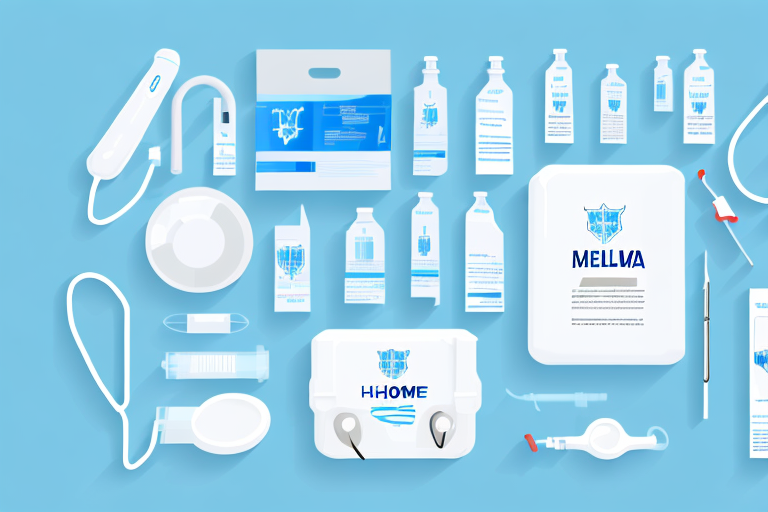How to Get IV Fluids at Home: A Step-by-Step Guide

IV fluid therapy is a common medical treatment that helps replenish the body's fluids and nutrients. Traditionally administered in medical facilities, it's now possible to receive IV fluids at home. Not only does this provide greater convenience for patients, but it can also reduce the risk of hospital-acquired infections. In this step-by-step guide, we'll walk you through the process of receiving IV fluids at home, from understanding the need for home IV therapy to managing potential complications.
Understanding the Need for IV Fluids at Home
Dehydration can be caused by a variety of factors, such as illness, exercise, or simply not drinking enough water. If left untreated, dehydration can lead to serious health problems, including kidney failure and seizures. It's important to recognize the symptoms of dehydration, which can include:
- Thirst
- Dry mouth and throat
- Dark-colored urine or decreased urine output
- Fatigue or weakness
- Dizziness or lightheadedness
When a person is dehydrated, their body lacks the fluids necessary to carry out essential functions. This can cause a range of symptoms, from mild discomfort to life-threatening complications. IV fluids can help to replenish the body's fluids and restore balance.
Medical conditions requiring IV fluids
In addition to dehydration, there are medical conditions that may require IV fluid therapy. These include:
- Chronic illness, such as kidney disease or heart failure
- Cancer treatments that cause dehydration
- Infections, such as sepsis or pneumonia
- Gastric bypass surgery
For patients with these conditions, IV fluids can be a critical part of their treatment plan. By providing fluids directly into the bloodstream, IV therapy can help to support the body's functions and improve overall health.
Benefits of receiving IV fluids at home
Traditionally, IV therapy has been administered in a hospital or clinic setting. However, advances in technology and changes in healthcare delivery have made it possible for patients to receive IV fluids at home. This can offer a number of benefits, including:
- Greater comfort and convenience: Patients can receive IV fluids in the comfort of their own home, without the need for travel or hospital stays.
- Reduced risk of hospital-acquired infections: By avoiding hospital stays, patients can reduce their risk of exposure to infections and other complications.
- Improved recovery time and outcomes: IV therapy can help to speed up the recovery process and improve overall outcomes for patients.
- Increased independence and control over their own care: By receiving IV fluids at home, patients can take a more active role in their own care and feel more empowered in their treatment.
Overall, IV therapy can be a valuable tool for managing a range of medical conditions and supporting overall health. By understanding the need for IV fluids and the benefits of receiving them at home, patients can make informed decisions about their own care and take steps to improve their health and wellbeing.
Assessing Your Eligibility for Home IV Fluids
Before you can receive IV fluid therapy at home, you'll need to determine your eligibility. This involves consulting with your healthcare provider, who will evaluate your condition and recommend the appropriate therapy.
Consulting with your healthcare provider
Your first step is to make an appointment with your healthcare provider. During this appointment, you'll discuss your medical history and current symptoms. Your provider may also order blood tests or other diagnostic tests to help determine your eligibility for home IV fluids.
It's important to be honest with your healthcare provider about your symptoms and medical history. This will help them determine if home IV fluid therapy is the right treatment option for you.
Determining the type of IV fluids needed
Depending on your diagnosis and symptoms, your healthcare provider may recommend different types of IV fluids. These can include:
- Normal saline: This is a solution that contains sodium chloride in water. It's commonly used to treat dehydration and electrolyte imbalances.
- Lactated ringers solution: This is a solution that contains sodium chloride, potassium chloride, calcium chloride, and lactate in water. It's commonly used to treat dehydration and electrolyte imbalances.
- Dextrose solutions: These are solutions that contain dextrose (sugar) in water. They're commonly used to provide calories and energy to patients who are unable to eat or drink.
Your healthcare provider will determine the type of IV fluid that's best for your specific condition and symptoms.
Evaluating your home environment
Not everyone is eligible for home IV fluid therapy. Your healthcare provider will also evaluate your home environment to ensure that it's suitable for administering IV fluids. This includes checking for:
- Adequate space for the IV pole and supplies: You'll need enough space to set up the IV pole and store the necessary supplies.
- Access to an electrical outlet: The IV pump will need to be plugged in to an electrical outlet.
- A safe and clean environment: It's important to have a clean and sterile environment to prevent infections.
If your home environment is not suitable for administering IV fluids, your healthcare provider may recommend that you receive treatment in a hospital or other healthcare facility.
Overall, assessing your eligibility for home IV fluids involves a thorough evaluation of your medical history, symptoms, and home environment. By working closely with your healthcare provider, you can determine if home IV fluid therapy is the right treatment option for you.
Preparing Your Home for IV Fluid Administration
Once you've been cleared for home IV therapy, it's time to prepare your home for administration. This involves creating a clean and safe space and gathering the necessary supplies.
Creating a clean and safe space
Before you begin administering IV fluids, it's important to create a clean and safe space. This can be achieved by:
- Cleaning the area with disinfectants
- Using a clean, flat surface to set up the IV pole and supplies
- Removing any tripping hazards from the area
It's important to have a designated area for IV fluid administration that is free from clutter and distractions. This will help ensure that you can focus on the task at hand and minimize the risk of accidents or complications.
You may also want to consider using a separate room for IV fluid administration, especially if you have young children or pets in the home. This can help keep the area clean and free from distractions.
Gathering necessary supplies
Before you begin administering IV fluids, you'll need to gather the necessary supplies, such as:
- IV pole
- IV tubing
- IV fluid bag and administration set
- Gloves and other protective equipment
It's important to have all of your supplies ready before you begin administering IV fluids. This will help minimize the risk of contamination and ensure that you can administer the fluids safely and efficiently.
You may also want to consider having extra supplies on hand in case of emergencies or unexpected complications. This can help you respond quickly and effectively in the event of an emergency.
Ensuring proper storage of IV fluids
It's important to store IV fluids properly to ensure their effectiveness. This involves keeping them in a cool, dry place and following any specific storage instructions provided by your healthcare provider.
You should also check the expiration date of your IV fluids before administering them. Expired fluids can be less effective and may even be harmful to your health.
If you have any questions or concerns about storing your IV fluids, be sure to speak with your healthcare provider. They can provide you with specific instructions and guidance to help ensure that your IV fluids are stored properly and administered safely.
Learning the Basics of IV Fluid Administration
Before administering IV fluids, it's important to familiarize yourself with the equipment and technique involved. IV (intravenous) fluid administration is a common medical procedure used to deliver fluids, medications, or nutrition directly into a patient's bloodstream. IV fluids can be used to treat dehydration, electrolyte imbalances, and a variety of other medical conditions.
Understanding the different types of IV access
There are different types of IV access, including:
- Peripheral IV access, which involves inserting the needle into the arm or hand. This is the most common type of IV access and is typically used for short-term treatments.
- Central IV access, which involves inserting the needle into a larger vein in the chest or neck. This type of access is used for long-term treatments, such as chemotherapy or dialysis.
It's important to consult with a healthcare professional to determine which type of access is appropriate for a patient's specific needs.
Familiarizing yourself with the equipment
It's important to become familiar with the equipment involved in IV fluid administration, including the IV pole, administration set, and needle. The IV pole is used to hold the bag of IV fluid and keep it at the correct height for infusion. The administration set includes tubing and a connector that attaches to the needle and allows the fluid to flow into the patient's vein.
It's also important to ensure that all equipment is sterile and free from contamination before use. This can help prevent infections and other complications.
Learning the proper technique for inserting an IV
Proper technique is important for a successful and safe IV insertion. This involves:
- Choosing a suitable vein: The healthcare professional will assess the patient's veins to determine the best location for the IV insertion.
- Cleaning the area with disinfectant: The area where the needle will be inserted is cleaned with a disinfectant solution to reduce the risk of infection.
- Using a sterile needle for insertion: A sterile needle is used to puncture the skin and enter the vein.
- Applying gentle pressure to the area after insertion: Once the needle is removed, gentle pressure is applied to the area to prevent bleeding and promote healing.
In addition to these steps, healthcare professionals may use other techniques to make the IV insertion process more comfortable for the patient. For example, they may use a numbing cream or spray to reduce pain or anxiety medication to help the patient relax.
Overall, IV fluid administration is an important medical procedure that requires proper technique and equipment to be successful. By familiarizing yourself with the different types of IV access, equipment, and techniques involved, you can help ensure that patients receive safe and effective treatment.
Administering IV Fluids at Home
Now that you understand the basics of IV fluid administration, it's time to begin the infusion process. Administering IV fluids at home can be a daunting task, but with the proper preparation and technique, it can be done safely and effectively.
Preparing the IV fluid bag and tubing
Before beginning the infusion process, it's important to ensure that the IV fluid bag and tubing are properly connected and sterile. This can be done by carefully inspecting the equipment and following the manufacturer's instructions for use. You'll also need to adjust the flow rate according to the healthcare provider's orders and ensure that the IV fluids are at the correct temperature.
It's important to note that IV fluids should not be used beyond their expiration date, as this can increase the risk of contamination and infection. Additionally, any unused IV fluids should be properly disposed of according to local regulations.
Inserting the IV needle
Once everything is prepared, it's time to insert the IV needle. This should be done by a trained healthcare professional or under their supervision. Proper technique for insertion includes cleaning the insertion site with an antiseptic solution, using a sterile needle and catheter, and securing the catheter in place with a sterile dressing.
During the insertion process, it's important to monitor the patient for any signs of discomfort or complications, such as bleeding, swelling, or infection. If any issues arise, the healthcare provider should be contacted immediately.
Monitoring the infusion process
Throughout the infusion process, it's important to monitor the patient's vitals and watch for any signs of complications, such as infection or infiltration. This can be done by regularly checking the insertion site for redness, swelling, or discharge, as well as monitoring the patient's temperature, blood pressure, and heart rate.
If any issues arise during the infusion process, such as a blockage in the tubing or a change in the patient's condition, the healthcare provider should be contacted immediately.
Removing the IV and disposing of supplies
Once the infusion is complete, it's time to remove the IV and clean up the supplies. This should be done by a trained healthcare professional or under their supervision. Proper technique for removal includes carefully removing the catheter and securing a sterile dressing over the insertion site.
After the IV is removed, it's important to properly dispose of any waste, including used needles and tubing. This can be done by following local regulations for medical waste disposal.
Overall, administering IV fluids at home requires careful preparation, proper technique, and close monitoring. By following these guidelines and working closely with a healthcare provider, patients can receive the necessary fluids they need in the comfort of their own home.
Managing Potential Complications
While home IV fluid therapy is generally safe, there are potential complications that can arise. It's important to be able to recognize these complications and know how to handle them. In this section, we will discuss some of the complications that can occur during home IV fluid therapy and how to manage them.
Recognizing signs of infection
Signs of infection can include fever, swelling, redness, and pain around the IV site. If you suspect an infection, be sure to contact your healthcare provider immediately. Infections can be serious and may require antibiotics or other medical intervention.
It's important to keep the IV site clean and dry to prevent infections. Wash your hands before and after handling the IV equipment and be sure to follow any instructions provided by your healthcare provider.
Addressing IV infiltration or extravasation
Infiltration or extravasation can occur when the IV fluid leaks into the surrounding tissue. If you notice swelling or discomfort around the IV site, stop the infusion and contact your healthcare provider. In some cases, the IV may need to be removed and a new site established.
To reduce the risk of infiltration or extravasation, make sure the IV catheter is inserted correctly and is secure. Avoid moving the IV site unnecessarily and be sure to monitor the site regularly.
Handling air embolisms and other emergencies
In rare cases, air embolisms or other emergencies can occur during IV fluid therapy. It's important to stay calm and follow any emergency protocols provided by your healthcare provider. If you experience symptoms such as chest pain, shortness of breath, or dizziness, seek medical attention immediately.
To reduce the risk of air embolisms, make sure all air is removed from the IV tubing before starting the infusion. Be sure to monitor the IV site and tubing for any signs of air bubbles.
It's also important to have a plan in place for emergencies. Make sure you have the contact information for your healthcare provider and any emergency services, such as 911. Keep a first aid kit and any necessary medications on hand.
By being aware of potential complications and taking steps to prevent them, you can ensure a safe and successful home IV fluid therapy experience.
Ensuring Ongoing Care and Support
Home IV fluid therapy can be a life-changing treatment for individuals who require it. However, it's important to remember that this type of therapy requires ongoing care and support to ensure its success.
One way to ensure ongoing care is to schedule regular check-ins with your healthcare provider. This can help you monitor your progress and make any necessary adjustments to your treatment plan. Your healthcare provider can also answer any questions you may have and provide guidance on how to manage any side effects or complications that may arise.
Joining support groups or online communities can also be a valuable source of ongoing care and support. These groups can provide a sense of community and understanding, as well as tips and advice from others who have experienced home IV fluid therapy.
Staying informed about new developments in home IV therapy is also important. As new technologies and techniques emerge, it's important to stay up-to-date on the latest advancements. This can help you make informed decisions about your treatment and ensure that you're receiving the most effective care possible.
It's also important to remember that home IV fluid therapy requires a significant amount of preparation and care. This includes properly storing and handling your IV fluids, as well as following strict hygiene protocols to prevent infection.
By following this step-by-step guide, you can ensure safe and effective home administration of IV fluids. Remember to always consult with your healthcare provider and follow any specific instructions provided. With the right preparation and care, home IV fluid therapy can provide greater comfort and convenience for those who need it.










